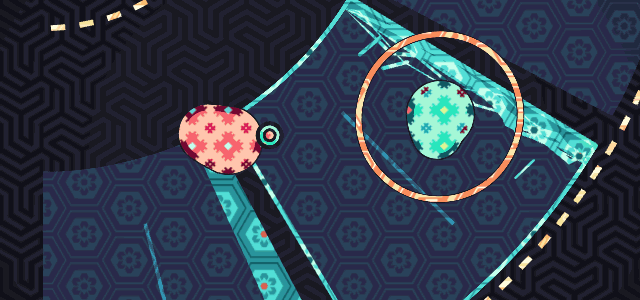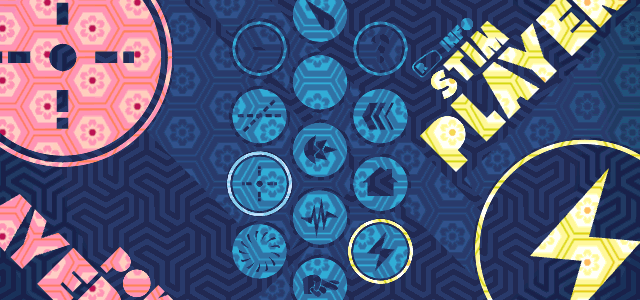JUMP TO
Introduction / Fundamentals / Dash / Cut / Wind / Ghost / Shoot / Poke / Nest / Pulse / Leech / Stim / Corp
PREVIOUS: Shoot
POKE
The cost for failing a poke is perhaps the second most extreme penalty in the
game, next to Corp’s penalty. Nevertheless, it remains one of the most potent,
frightening powers to oppose.
To be good at Poke, you must first develop an intuitive understanding of people's
movement in and out of your poke radius. This takes some amount of time, and you
should expect to lose games while learning it. Consistently landing a poke requires
a certain minimum amount of skill. Even once you have the basic timing down, the
opponent may delay their approach in a myriad of ways - reversing direction, slowing
down, stopping, slightly angling their approach, dancing in circles outside your
radius... a good Poke player should anticipate every one of these delays, and many more.

As a Poke player, you *must* establish that you can land a poke as soon as
possible. Poke benefits a great deal from the time the attacker wastes dancing
outside your range. If you cannot demonstrate your poke's accuracy to the
opponent, however, don't expect your opponent to fear it. Remember that you
benefit from any amount of time the opponent spends outside your poke radius.
If you poke and miss, you effectively cut short that time and surrender the
ball to your opponent. Don't lose sight of the value of possession over the
value of landing a poke. Sometimes you should let the opponent dance outside
as long as they please, with you passively gaining points as they do. Even once
the opponent crosses your threshold, you still have a shield to defend from steals.
Remember, too, that as Poke, your own movement is one of your most vital
tools. Although the opponent will always move faster, your own mobility is
not non-existent. Retreating as the other player approaches you only to lurch
toward them and poke at the last second will frequently catch your opponent.
Sometimes, even, you can land a poke on a player dancing to close to you by
simply advancing and poking them, as many attackers will underestimate your
mobility and will expect you to play a purely sedentary style. For the attacker,
an effective dance depends upon their estimation of the space between both of
you, and every frame you remain stationary makes this estimation easier.
Occasionally, I'd even advise entirely abandoning the zone upon which you are
standing (thereby increasing your mobility) to seek a poke against the opponent.
If you land the poke, the increase in mobility will have been well worth the
brief loss of passive points.

Following a poke, the opponent cannot move for about 120 frames and, at the end of this time, will spend several frames regaining momentum. Poking them during this period will ensure a virtually free second poke, you can lock them in stun. On unbounded maps, the opponent will drift far enough out of range following multiple pokes that further extension bears little fruit, but on bounded maps (Donut, Rose, etc) one could poke the opponent a theoretically infinite number of times. To defend against this, the opponent need only point the thumbstick on their controller away from you at the end of stun to add another 60 frames to their stun. Should you chose to poke as the opponent does this, you'll find them still in stun, and miss. However, if you correctly predict their stun extension, they'll have put themselves in an even worse position than they were before.

Most of the time, you'll need to make a hard read to land a poke, but
there are certain situations that tilt the game in your favor.
For example, immediately following a blocked steal, the game kicks
the attacker back from the defender a short distance. It just so
happens that this distance exactly matches the distance of the Poke
reticule. Thus, with proper timing, a successful block almost always
guarantees a successful poke. Bear in mind, the attacker may still
move during this kickback, and if they hold the thumbstick directly
toward or away from the defender they will disrupt the delicate timing
of this combo. That said, the defender may still correctly predict
and compensate for the direction the attacker holds (away, none, in),
landing the poke anyway. To hit an attacker who holds away, simply
poke sooner than you otherwise would. To hit an attacker who holds in,
however, you'll need to point the thumbstick away from the defender,
thereby drifting in the same direction they do. Otherwise, they will
remain inside your radius and you will miss the poke.
A keen poke player may also set themselves up for a poke following a
well angled steal. When stealing the ball, Poke should attempt to angle
the ball such that it reflects off a nearby wall and returns to a place
where it may be picked up exactly within poking distance of the opponent.
After Poke picks up the ball, the opponent will remain stunned for a
few frames, and then begin to move. A poke should be timed to hit the
opponent after their post-steal stun ends, but before they can gain
enough momentum to escape Poke's radius.

In contrast to most powers, Poke is defensive. It will often be used in conjunction with the opponent's power. A few short notes on those interactions...
Dash vs Poke - Dash mostly invalidates Poke's keep-out game, skipping right over the Poke reticule. However, if the opponent's dash connects with you, it will typically knock you back into perfect poking range. So while a clever Dash may find it easy to move inside a Poke radius, the threat of a poke should prevent Dash from ever connecting.
Cut vs Poke - Cut sacrifices so much mobility to lay a cutline, Poke shouldn't have much difficulty chasing them down. This match-up is horribly tilted in Poke's favor.
Wind vs Poke - Wind can make Poke's job a little bit harder, although not impossible. Remember that once a player enters a wind stream, they tend to ride it all the way down, making players attempting to bypass your radius with a windstream a little more predictable.
Ghost vs Poke - Although Ghost turns invisible, it does not become invincible. A Ghost may still be poked while ghosting. Additionally, the Poke reticule vaguely indicates Ghost's position while invisible.
Shoot vs Poke - Much like Dash, getting hit by the right shot at the right distance can send you backward into the poke radius. Be attentive.
Nest vs Poke - A Nest player can be poked while building their nest, but unless they begin building near enough the poke player, it might not be worth the time spent to do so.
Pulse vs Poke - This match-up swings a little bit in poke's favor, as keeping the other player outside your radius means you don't have to worry about your shield being pulsed for a while.
Leech vs Poke - A failed leech stuns the opponent, and a stunned player may be poked on wake-up. Now instead of having only one way to land the first poke, you have two.
Stim vs Poke - Against most classes, Stim can build a full meter for free once the opponent has wasted their shield. Not so with Poke. Once you run out of shield, poke - it does not matter if it connects or not, only that it prevents Stim from gaining a full meter. Additionally, should a Stim player be silly enough to initiate their stim while you have the ball, poke them before the animation ends. Against Poke, the most optimal time for Stim to activate is just after stealing the ball. At all other times, Poke will likely stun them for the first bit of their stim. Following a steal, because the stim activation animation is so long, you might occasionally wake up before the animation is complete, giving yourself a chance to recapture the ball.
NEXT: Nest